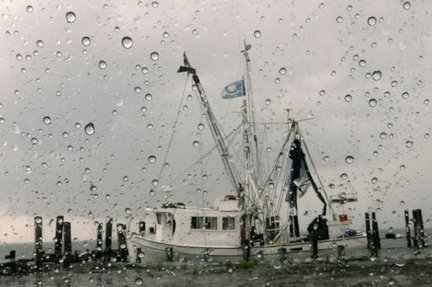
"Major oil leaks from damaged pipelines could have irreversible impacts to the ocean environment," conclude the authors of a study of the underwater effects of Hurricane Ivan in 2004 published last week in Geophysical Research Letters, a journal of the American Geophysical Union.
The report is one of several scientific studies using data gathered during Ivan, which traveled across an array of underwater instruments the scientists had moored in several locations along the Gulf of Mexico shelf just south of the Alabama coastline to measure current flows.
Ivan made landfall at Gulf Shores, Ala., on Sept. 16 at 2:30 a.m., packing winds of 120 mph, or Category 3 strength. But 12 hours earlier, its top winds were closer to 132 mph, or Category 4 strength, as it crossed the underwater study area.
The instruments measured high levels of stress on the Gulf floor at depths of 200 feet and 300 feet, said William Teague, a Navy oceanographer and co-author of the study. The forces beneath the ocean were equal to as much as 40 percent of the stress caused by the Category 4 winds that were causing the 90-foot waves on the surface.
"It stirred sediment up to 25 meters (82 feet) or better off the bottom," he said. The stresses during Ivan were enough to deepen the area in which the instrument packages were tethered by more than a foot, he said.
Waves created by the hurricane transfer some of their orbital motion into the water beneath them -- think of the force created by waves breaking on the beach -- and the researchers found that motion was exacerbated by ocean currents spun up by the storm at the same time. The combination scours sediment from the sea floor and can actually cause horizontal mudslides that have been known to topple oil rigs.
A major surprise found by the researchers was that the increased intensity of the underwater currents continued for a week after Ivan made landfall, Teague said. The lengthy hurricane effect on the currents is similar to a spoon stirring a bowl of water, with the water continuing its circular motion long after the spoon is removed.
"It's well known that pipelines are damaged by hurricanes," Teague said. "Statistics published by the Minerals Management Service after Hurricane Ivan stated that there were 168 pipeline damage reports. In Katrina, there were even more.
"The damage reports ranged from dented to kinked pipelines, to pipelines that were pulled apart and ruptured," he said. "The reports refer to pipelines that are buried or damage that is caused by underwater mudslides. Based on our research, they equate to a snow avalanche underwater -- imagine a big mound of mud rolling toward you."
Storm toppled oil platform
That's exactly what happened during Ivan to a Taylor Energy Co. oil platform that was sitting in 479-foot-deep water on Mississippi Canyon Block 20, 19 miles south of the mouth of the Mississippi River, a spokesman for the company said.
"The platform was toppled by a subsurface mud slide triggered by storm surges with 100 foot waves for 16-18 second periods," said Denise Fields, a Taylor spokeswoman. The 16 seconds to 18 seconds refers to the time between waves, and is an indicator of their size and strength.
Fields said the underwater mudslide covered the wellheads with more than 100 feet of mud. An MMS report says the platform was later found lying on its side, 800 feet away from the wellhead.
Diamond Offshore Drilling Inc. is now attempting to plug wells that are leaking about 9 gallons a day of oil, using its Ocean Saratoga drilling rig, Fields said.
The Navy study also warns that the effects of such mudslides could cause problems at the edge of the shallower shelf, where it overlooks the steep slope into the Gulf's deepwater environment.
"The cumulative effects of enhanced bottom stresses and associated transport of large quantities of sediment along the shelf edge could be a trigger mechanism for a slumping or mass-wasting event at the shelf break," the report said, the equivalent of an underwater cliff collapsing and falling into the abyss below.
Teague termed the chances of such an event happening as being very low.
The results of the Ivan-related current and wave studies are likely to be incorporated in computer models used by engineers to design offshore structures, including pipelines and oil exploration and production rigs, Teague said.
Mark Schleifstein can be reached at mschleifstein@timespicayune.com



Reader Comments
to our Newsletter